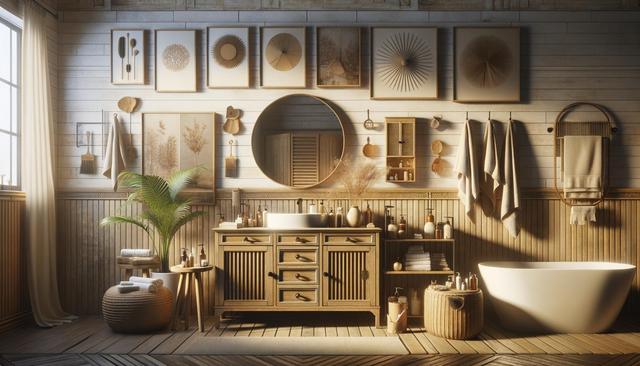
How to Choose a Vanity That Complements Your Space and Style
Assessing Your Space and Layout
Before selecting a vanity, it’s essential to evaluate the available space in your bathroom. A vanity that overpowers the room can make the area feel cramped, while one that’s too small may not offer enough storage or counter space. Start by measuring the width, depth, and height where you plan to install your vanity. Don’t forget to consider the placement of doors, windows, and other fixtures like toilets or showers that may affect your layout. Think about how people move through the space and whether a freestanding, wall-mounted, or corner vanity would be most practical.
Consider these layout tips when choosing a vanity:
- Ensure at least 30 inches of clearance in front of the vanity for comfortable use.
- Leave enough space between the vanity and other bathroom elements to allow for easy cleaning and access.
- Plan for plumbing lines—moving them can be costly, so working with existing plumbing is often more budget-friendly.
Understanding your layout helps narrow down choices and ensures your vanity integrates well with the rest of the room.
Choosing the Right Size
Size plays a crucial role in both the functionality and appearance of your bathroom vanity. Vanities come in a range of widths—from compact 18-inch models ideal for powder rooms to 72-inch double vanities suited for master bathrooms. Select a size that fits comfortably within your space while meeting your usage needs. For example, a single-sink vanity may suffice in a guest bath, but couples sharing a main bathroom might benefit from a double-sink option.
Here are factors to keep in mind when deciding on size:
- Counter space: More width typically offers more surface area for daily items.
- Storage capacity: Larger vanities usually provide more drawers and cabinets.
- Proportional balance: Choose a size that feels visually balanced with the rest of the room.
Even in small spaces, you can maximize utility with smart design features like vertical storage or open shelving. The key is to find a vanity that fits your room without visually overwhelming it.
Exploring Storage Needs
A vanity isn’t just a decorative element—it also serves as essential storage. Consider your daily routine and what items you need close at hand. Do you have a lot of skincare products, hair tools, or cleaning supplies? Do multiple people use the bathroom? These questions can help guide your decision on the type and amount of storage you need. Vanities typically offer a mix of drawers, cabinets, and shelves, so think about which configuration suits your lifestyle.
Common storage features include:
- Soft-close drawers for quiet, smooth operation
- Deep cabinets for bulky items like towels or hair dryers
- Dividers and organizers to keep small items tidy
If you’re tight on space, look for vanities with open shelves or wall-mounted units that create a lighter visual impression while still offering storage. Matching your vanity’s storage design to your needs can streamline your routine and keep your bathroom clutter-free.
Selecting a Style That Reflects You
The style of your vanity should align with your overall bathroom decor. Whether you prefer a sleek modern look, rustic farmhouse charm, or a timeless traditional aesthetic, there are vanities to suit every taste. Think about the materials, finishes, and hardware that will complement your existing or planned design. For instance, a vanity with clean lines and a glossy finish may suit a contemporary space, while a wood-grain finish with antique handles can enhance a more classic design.
Popular vanity styles include:
- Modern: Minimalist design, flat-panel doors, metal accents
- Traditional: Detailed molding, rich wood tones, ornate hardware
- Transitional: A blend of classic and modern elements
Color is another important consideration. Neutral shades like white, gray, or beige offer versatility, while bold colors can create a focal point. The right style can tie your entire bathroom together and make the space feel more cohesive and inviting.
Factoring in Countertop and Sink Options
Your vanity’s countertop and sink are where form meets function. The countertop material should be durable and easy to clean—options like quartz, granite, and solid surface are commonly used for their resilience and aesthetic appeal. Consider how much counter space you need and whether an integrated sink or a vessel sink better suits your preferences. Integrated sinks offer a seamless look and are easy to maintain, while vessel sinks add a stylish, sculptural element to the bathroom.
When choosing a countertop and sink, consider the following:
- Material durability and maintenance level
- Color and texture that complement the vanity base
- Sink shape and size for both function and design appeal
Also, think about faucet placement and configuration. Some vanities come pre-drilled for one-hole or three-hole faucets, so make sure your fixtures align with the countertop design. By aligning your countertop and sink choices with your daily habits, you can ensure your vanity is as practical as it is visually appealing.
Conclusion: Making a Choice That Works for You
Choosing the right vanity involves more than just picking a design you like—it’s about creating a functional, organized, and comfortable space that supports your daily routine. By considering your bathroom’s layout, your storage needs, and your personal style, you can find a vanity that enhances both the look and usability of your space. Whether you’re renovating a master bathroom or updating a guest powder room, a carefully chosen vanity brings lasting value and satisfaction to your home.


